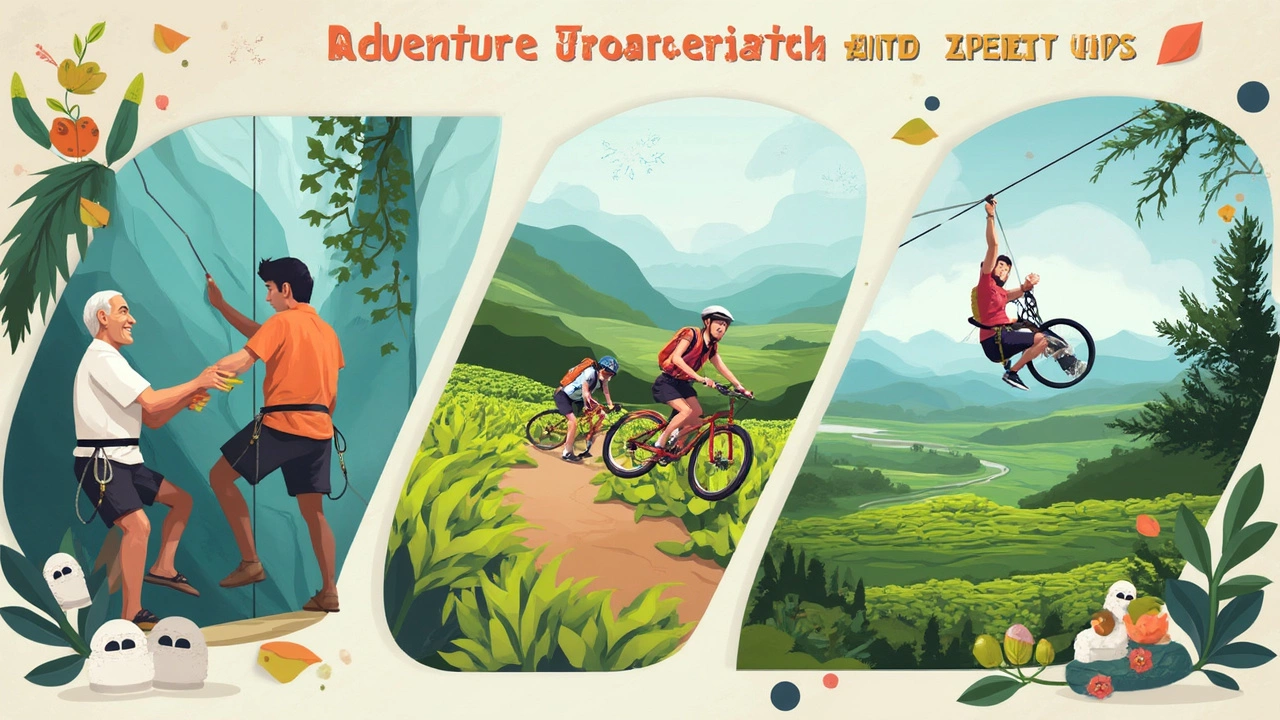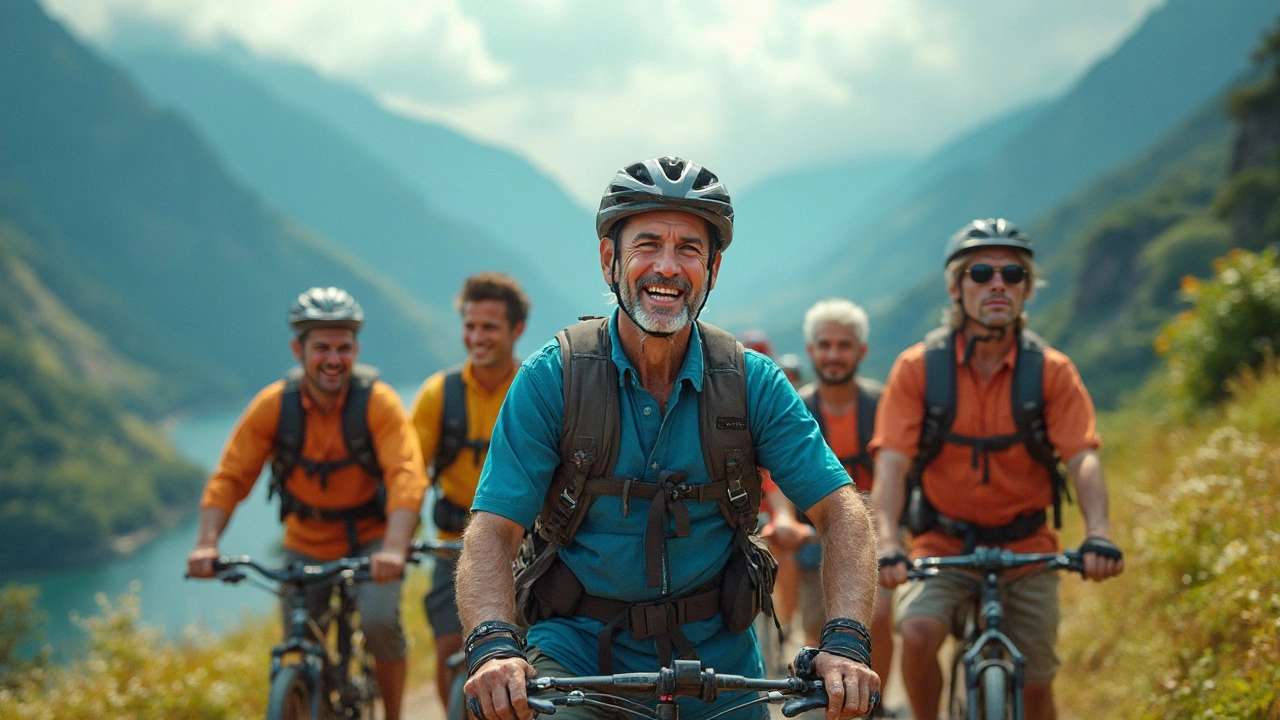If you’re crazy about adventure sports, you’ve probably wondered how long you can actually keep doing them—especially once you have a family or life starts to feel, well, grown-up. Spoiler: it’s not what you see in those viral videos. Each sport is different. Some let you keep chasing thrills for decades, others might be a young person’s game.
When I first thought about this, I imagined only twenty-somethings could rock-climb, or that paragliding was just a midlife crisis hobby. Turns out, the longest adventure sports careers aren’t always in the flashiest spots—and often, it comes down to discipline and knowing how to pace yourself. In India, the climate, culture, and sheer variety of locations means different sports suit different ages. The trick is picking the one that fits your life, not just your Instagram feed.
It’s not just about how tough you are or how hard you push—it’s about consistency and injury prevention. Athletes I’ve spoken to swear by yoga and functional training as the real ticket to a long career, no matter the sport. So, which sport actually keeps people going the longest? The answer isn’t obvious, but it can change how you plan your own adventure journey.
- What Makes an Adventure Sport Career Last?
- Top Adventure Sports and Their Career Spans
- Stories of Athletes Who Keep Going
- Tips to Extend Your Adventure Sports Journey
What Makes an Adventure Sport Career Last?
Sticking with adventure sports for the long haul isn’t about being tougher than everyone else. It’s a mix of smart planning, listening to your body, picking the right gear, and building a solid support system. In India, this means knowing when to push and when to hold back, since weather, terrain, and access to good training matter a lot.
The biggest factor? Avoiding injuries that can shut down your plans for months—or even years. Most pros in outdoor activities actually put more time into recovery and joint care than training itself. Yoga, stretching, and physiotherapy are as important as the sport itself. An old saying among climbers is "it’s the warm-up and cool-down that keep you going, not the summit shot."
- Career longevity depends heavily on cross-training. The top paragliders, ultrarunners, and bikers in India often switch up their training to avoid wearing out certain muscle groups. Mixing things up with swimming, hiking, or gym sessions slows down the wear and tear.
- Good nutrition and sleep are non-negotiable. Not glamorous, but athletes who stick around long-term almost always have strict routines around recovery and rest. Even Olympics-level Indian kayakers rave about dal chawal and proper sleep over supplements.
- The right mindset goes a long way. Feeling you have something to prove can lead to overdoing things and burning out. The ones who treated sports lifespan as a journey, not a race, tend to last longer—and often have more fun along the way.
- Staying updated with new technology helps, too. In the last decade, lighter mountain bikes, safer climbing rigs, and weather-tracking apps have actually helped Indian adventurers stay safer and compete longer. Investing in the right kit is a total gamechanger.
| Factor | Impact on Career Longevity | Common Tips |
|---|---|---|
| Injury Prevention | Reduces career breaks, keeps you active | Warm-up, cool-down, regular stretching |
| Cross-Training | Spreads out physical strain | Switch up activities, add strength sessions |
| Nutrition | Improves energy and recovery | Balanced meals, hydrate, prioritize sleep |
| Mindset | Prevents burnout, keeps motivation strong | Set long-term goals, enjoy the ride |
| Gear & Tech | Keeps you safe, boosts performance | Invest in upgrades, stay up to date |
For parents like me, juggling adventure sports and family means planning ahead. Sometimes, the best way to stay in the game is sharing the stoke with your kids or joining a club for support. No matter your skill or age, factoring in realistic recovery time and steady upgrades is what makes a career actually last in this wild world.
Top Adventure Sports and Their Career Spans
Not all adventure sports treat your body the same way, so how long you can keep going depends a lot on which one you pick. Some are all about short bursts of energy, others let you cruise for decades if you play your cards right. Here’s what to expect from some of India’s most popular outdoor activities:
- Paragliding: Surprised? Most pilots stay active well into their 60s, sometimes more. As long as you keep up with your medical checks and practice safely, age is mostly just a number here. You’ll often see instructors in their 50s teaching newbies in Bir Billing or Kamshet all season long. The most common hurdle is eyesight or leg strength for takeoffs and landings, but these can be managed.
- Rock Climbing: If you think climbing is only for the super young, check out the local climbing communities in Hampi or Badami. Plenty of climbers keep going strong into their 50s, especially those who stay injury-free and focus on technique over brute strength. Competing at the highest level gets tough after your 30s, but recreational climbing is honestly for life if you listen to your body.
- Whitewater Kayaking and Rafting: The adrenaline is real and so is the risk. Guides and expedition leaders on rivers like the Ganga usually stay in the game through their 40s, sometimes longer if they avoid major injuries. The trick here is keeping the core strong and avoiding burnout during those crazy monsoon months.
- Trekking and High-Altitude Hiking: This is the real winner for career longevity. Trekkers and guides in the Himalayas often start young, but experienced guides are still going strong in their 60s. With sensible pacing and altitude experience, age becomes less important than stamina and judgment. If you want to rack up years and stories, trekking is your safest bet.
Here’s a rough idea of how long you can expect an active career in these sports:
| Sport | Average Career Span (Years) | Things That Cut Careers Short |
|---|---|---|
| Paragliding | 25-40 | Vision issues, injuries, failing medicals |
| Rock Climbing | 20-35 | Finger/joint injuries, lack of recovery |
| Whitewater Kayaking | 15-30 | Back/shoulder injuries, risk tolerance |
| Trekking/Guiding | 30-40+ | Altitude sickness, chronic knee/foot pain |
If you’re looking for the adventure sport with the longest career span in India, trekking easily takes the crown. But if flight is in your veins, paragliding is surprisingly friendly for all ages with the right habits. For the high-impact stuff like kayaking or competitive climbing, you’ll want to invest in recovery and pick your battles.

Stories of Athletes Who Keep Going
When you look at adventure sports in India, the people with the longest careers aren’t always the ones you expect. Take Bachendri Pal, the first Indian woman to scale Mount Everest. She kept leading expeditions and training future climbers into her 60s, proof that in mountaineering at least, age doesn’t close any doors if you stay strong and smart.
In other adventure sports like paragliding, you’ve got legends like Gurpreet Dhindsa, who’s been flying over the Himalayas for more than 20 years. He talks openly about using regular fitness routines to manage the physical demand—nothing outrageous, just small daily habits and a focus on recovery. You’ll hear similar things from the country’s top river rafters, many of whom guide commercial rafting trips well into their late 50s.
Career longevity in these sports often depends on switching gears when needed. Arun Nayak, a veteran kayaker from Rishikesh, started coaching after a couple of shoulder injuries. Now, he gets to be part of the action and pass on tips to kids half his age. There’s a real culture of mentorship in Indian adventure sports, where older athletes guide newbies instead of just dropping out when the competition days are done.
Numbers speak, too. In a survey conducted by the Adventure Tour Operators Association of India in 2023, over 40% of professionals in trekking and mountaineering had active field roles after age 45. Here’s a look at typical age ranges for staying active (not just coaching) in a few popular adventure sports:
| Sport | Average Career Span (Years) | Typical Max Age |
|---|---|---|
| Mountaineering | 25–30 | 65+ |
| Paragliding | 20–25 | 60+ |
| White Water Rafting | 15–20 | 55–60 |
| Trekking | 30+ | ANY (many over 70) |
If you’re serious about a long ride in adventure sports, it pays to learn from people who are still out there making it work. Keep checking what works for them: strong support networks, steady training, and listening to your body when it says slow down. Anyone can have a wild few years. The real legends stay in the game for a lifetime.
Tips to Extend Your Adventure Sports Journey
Most folks think you’ll last longer in adventure sports if you just "toughen up." Honestly? The real key is looking after your body and being smart about how you train. I’ve seen way too many talented climbers and bikers put themselves out of the game with silly injuries they could have avoided. Use these tips to stay out there for the long haul, whether you’re in the Himalayas or exploring the Western Ghats.
- Don’t skip your warm-up and cool-down: It sounds basic, but serious adventure athletes all do it. Five minutes of dynamic stretches or easy jogging gets your muscles ready. Cooling down with gentle stretching prevents sore joints the next day.
- Cross-train with yoga or pilates: Most top Indian kayakers, surfers, and climbers use yoga to boost flexibility and balance. You don’t have to become a yogi—just try basic poses twice a week. Your back and knees will thank you.
- Listen to your body: If you feel a twinge, don’t ignore it. Most chronic injuries in adventure sports start as small annoyances.
- Gear matters: Using the right equipment for your age, size, and skill level lowers your risk of injury. Helmets, shoes, even harnesses should fit you—not the friend you borrowed them from.
- Rest days aren’t lazy: Top-level athletes build in rest to let their muscles recover. You need to do the same, even if it’s just swapping a tough session for a walk or a swim.
| Sport | Average Career Span (Years) | Common Injury Risk |
|---|---|---|
| Rock Climbing | 20-30 | Finger tendons, shoulders |
| Paragliding | 25-35 | Back, knees |
| Whitewater Kayaking | 15-25 | Shoulders, wrists |
| Mountain Biking | 20-30 | Wrists, collarbone |
Hydration and nutrition play a big part too. My own energy used to dip like crazy until I started packing trail mix, fruit, and 2 liters of water for every trip. Even on short rides with my kids, snacks and water keep us moving and happy.
Another biggie—balance skill training with fun. If adventure becomes all competitions and drills, burnout hits fast. Try switching up your routes, or go out with a group for new ideas and company. That social side can keep you engaged for years.
